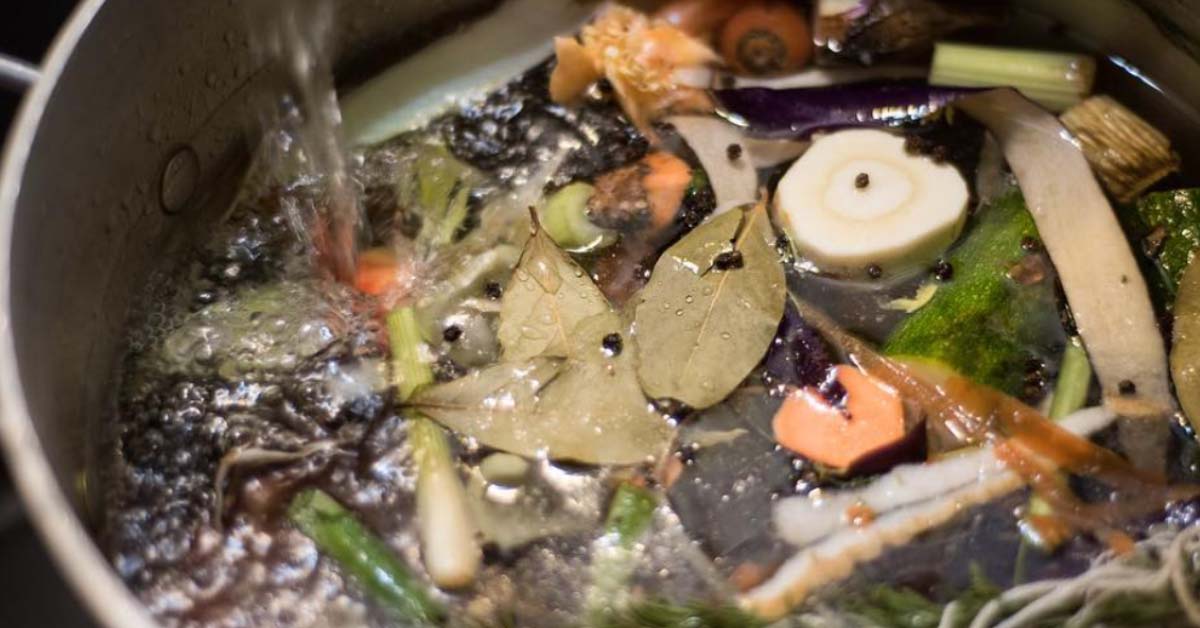The first time I made bone stock, I felt like I was channeling the spirit of Madame Barbe-Nicole Clicquot…
…it looked like champagne.
 I stared in wonder at the tiny bubbles of fat and collagen swirling in the sunflower yellow liquid. It was the most beautiful thing I have ever seen in a kitchen.
I stared in wonder at the tiny bubbles of fat and collagen swirling in the sunflower yellow liquid. It was the most beautiful thing I have ever seen in a kitchen.
Homemade stock feels like an incredible luxury. Boxed, canned, or bouillon…there is no substitute for the stuff.
Everything you’d expect from boxed it tops without requiring an iota of talent in the kitchen.
Aroma. Taste. Viscosity. Nutrition. And it costs nothing.
You can make incredible stock without spending anything extra.
The secret to making stock is a beautiful one wherein waste reduction, health and vitality, and poetry meet in a pot. Let me introduce you to Mirepoix.
Mirepoix as Magic.

The origin of the Mirepoix is at once so ancient and culturally-fluid, it defies any factually-based narrative.
True to that enigmatic origin, no one can give us a set recipe or ratio for its creation… even the precision-loving French understand it’s je ne sais quois in culinary art.
Mirepoix’s acolytes know only one path to enlightenment: Intuition.
Take for instance Mirepoix’s many alter egos- the Sofrito of Spain (or soffritto to the Italian), the Holy Trinity of Cajun cooking, the Suppengrün of Germany. Between them are woven common threads but not one must-have element.
Everyone uses onion, except Germany. And everyone uses celery, except Spain…or the French but only if they are making bourguignon.
Like so much of life is the Mirepoix: In the face of so many exceptions, there are no rules.
I fantasize Mirepoix came as spontaneous light, wrapped in the mist of time-before-time alongside the origin of man.
After all, the idea of starting your meal prep with aromatic vegetables isn’t an invention of western-culture. The concept peeks out from the cooking pots of Prehistory Africa. It dances through the dusty records of an enlightened Asia where – five centuries before Columbus- scholars had predicted the existence of the Americas while eating meals grounded in sauteed garlic and green onions.
Like all old deities, Mirepoix is one legend disguised to which each culture assigns its own face. It’s the heroine in your soup pot, the strength in your paella, the depth in your stir fry.
If the ancient Greeks would have come to an agreement on what goes into a Mirepoix, perhaps we’d have a constellation in the shape of chopped vegetables.
Mirepoix As An Irreplaceable Foundation

Modest. Foundational. She is the philosophical heart of every recipe beginning with “first, take an onion…”
Perhaps not poetry but kitchen scraps. Or maybe poetry and kitchen scraps. She’s the patron saint of kitchen waste reduction.
There isn’t a day in any Michelin-star restaurant in which Mirepoix doesn’t make an appearance.
When making a dish in final form, Mirepoix is redressed as a series of humble but foundational vegetables. Carefully chopped carrots, onions diced small or sliced into slender moons, arches of celery and minced garlic.
In stock Mirepoix serves as a supporting actress. Strained from the final product, she uses her earthy flavor to give foundation to the viscous cartilage pulled from simmered chicken backs and beef knuckles to birth vitality into the essence of a dish.
In the winter we always have a small pot of bubbling vegetable scraps. Mirepoix is old magic, turning water into flavor and life.
Yes, you can buy bouillon or paste- but why? Making stock (which, comes from bones, broth comes from meat…as I was recently corrected) is free, delicious, and so much better.
The only cost is attention.
Those carrot peels and herb stems? Throw them in the pot.
That sad-looking green pepper that was lost on the back shelf? Throw it in, too.
Tough oyster mushroom anchors, papery tomato peels and corn cobs…all find their way into some stock by way of mirepoix.
Environmentally speaking, waste not…want not.
There are Only Two Constraints to Making Mirepoix Magic:

#1: Time
Use your scraps frequently or risk a composting biohazard that covers your cooler in a blanket of mold.
#2: Intuition
Your choice on how you want to acquire it.
The easy way is Googling it.
Or, if you like to build character, you can find out through experimentation why never to include potato peels or how zucchini skin turns everything the color of the Chicago River on St. Patrick’s Day.
The only “hard no’s” I have for Mirepoix are:
- Never invite the Brassica family…Cabbage or Cabbage-Relatives (Cauliflower, Broccoli, Brussel Sprouts…the smell is terrible)
- Save the potatoes for the compost (no critical damage but makes a starchy, “dirty” looking broth)
- No fingers, chop with care. Vegetables, especially parsnips, can be deceptively dangerous when dicing.
Be wary of red onions, beets, and deep green vegetables that can turn your broth odd colors.
In the true spirit of Mirepoix, think about your menu and create stocks accordingly…
Lamb stocks get an extra helping of sage, leek-ends, and whole peppercorn.
Corncobs and garden peppers get tossed in with shrimp shells for the base of true gumbo.
I keep chicken stocks neutral, with the “classic three” of carrot, celery, and onion to maintain versatility.
At home, vegetable stock can be made quickly from dinner scraps and stored in the fridge for up to one week. Used for soups, it is gentle and light. It makes a solid risotto. My favorite use? Boil your pasta in it for extra flavor. If you have no immediate need, freeze into quart bags for a later date.
Here is a Simple Guide to Reducing Waste in Your Own Kitchen by Crafting Vegetable Stock:

#1 Use a medium to large stock pot, one that will allow you to achieve 2-3 parts water to 1 part vegetable scraps.
#2 Drizzle olive oil into the pot after it warms (to prevent burning your oil). If you’re a careless chef, use avocado or coconut oil, both of which are less sensitive to heat. You can use small pat of butter as well if you aren’t concerned with crafting a vegan base.
#3Place a halved onion or onion scraps, without skins, into the pot to brown. This will give your vegetable stock a rich, tawny color and a deeper flavor. Remember that using red onions will color your stock.
#4 If desired, after browning the onion, gently sautee other vegetable scraps. Or not. It depends on the flavor, and amount of attention, you wish to give your stock.
#5 Top the pot off with 2-3 parts water. Add bouquet garni, additional herbs, hard spices, bay leaf, etc.
Unlike bone stocks, vegetables release their flavor easily. Bring to a simmer but never to a boil. Boiling will break down your vegetables and risks a cloudy stock. Furthermore, some vegetables if overcooked will act as a “sponge”- trapping your beautiful stock at the end of the process.
#6 Simmer gently 20-45 minutes as desired.
#7 Strain through a wire mesh covered in cheesecloth.
Here’s a secret about stocks I’ve discovered only in the last season: even the most aromatic stocks don’t typically taste as you’d expect until salt, acid, or fat is added.
This is why so many of your boxed grocery stocks have a high sodium content…people expect them to taste pretty much like chicken soup straight from the box.
But you know better.
Save the salts and fats until cooking. This is just a base. Mirepoix will reveal it’s magic when in final recipe form.
Allow the natural flavors of the spices, meats, and vegetables to rest, breathe, and intensify on their own. Salt your stock before serving, not before storage.
Enjoy the magic,
Meredith Gernigin
Lead Editor




